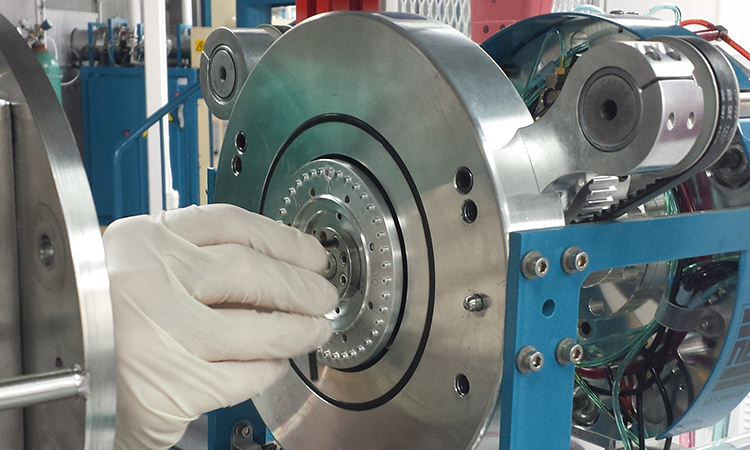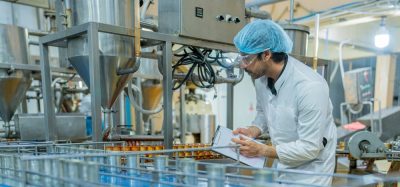The importance of reporting carbon-14 results under a standard
Posted: 11 December 2020 | Haley Gershon - Beta Analytic, Maren Pauly - Beta Analytic | No comments yet
Haley Gershon and Maren Pauly of Beta Analytic explain how carbon dating can be used to determine how natural a product’s ingredients really are.


Accelerator mass spectrometry (AMS) is used to carbon date materials.
Measuring carbon-14 levels through radiocarbon dating to determine the age of organic material is an established method that has been used since the 1940s. Accelerator mass spectrometry (AMS) is a highly sensitive method that is able to detect low concentrations of isotopic abundances, such as carbon-14.
This technique is widely used among the archaeology, geology and hydrology fields as a means to date material up to approximately 50,000 years ago.1 More recently, however, the radiocarbon-dating method has also been a viable tool for biobased-content testing, naturally sourced-ingredient testing, biogenic-content testing of biofuels, and biogenic-content testing of carbon dioxide (CO2) emissions and solid waste fuels.
When using carbon-14 testing to analyse samples for the aforementioned purposes, it is critical to report the measurements according to recognisable and established testing standards.
Overview of carbon-14 testing
Carbon-14 dating is based on the premise that all terrestrial living organisms absorb CO2 from the atmosphere during their life. This atmospheric CO2 contains radioactive carbon (14C), which enters the atmosphere via cosmic rays from the sun. Once the living organism dies, the 14C signature decays over time in a predictable way, allowing scientists to estimate the length of time since death, and thus estimate the age of any organic matter.1 Using this method, it is possible to determine if a material is comprised of recently living organics or fossil/petrochemical-derived material.
Carbon-14 standards
Carbon-14 testing laboratories, such as Miami-based Beta Analytic, report test results as a percentage of biobased (or biogenic) carbon content according to established testing standards.2 Depending on the application of carbon-14 testing, certain standards are used.
|
Application |
Naturally-Sourced Ingredient Testing |
Biobased Content Testing |
Biofuel Carbon Content Testing |
Renewable Carbon Testing |
|
Standards |
ASTM D6866 ISO 16620
|
ASTM D6866 ISO 16620 ISO 19984 EN 16640 CEN/TS 16137 CEN/TS 16295 EN 16766 EN 16785 EN 16807 |
ASTM D6866 |
ASTM D6866 EN 15440 ISO 13833* |
*Applicable to stationary exhaust gas sources only
Naturally-sourced ingredient testing
Natural versus synthetic product testing uses carbon-14 analysis and enables regulatory bodies, manufacturers and suppliers, distributors, and consumers to validate natural-sourced claims.
For example, the Flavouring Regulation (EC) No 1334/2008 of the European Parliament specifies requirements for the use of the term “natural” with regard to any products containing flavourings. According to the regulation, all such products must contain only natural flavouring substances, with no artificial sources.
Within the flavour and fragrances market, the readily available and lower cost petrochemical synthetic alternatives are often used to replace natural sources. This includes lignin vanillin (by-product of paper industry), ethyl vanillin (a coal tar derivative) and bio-vanillin (microbial fermentation derivative) used in place of natural vanilla beans (vanilla planifolia) as well as the chemical synthesis of urea as a replacement for natural caffeine (coffee beans, tea leaves, guarana berries).
Natural product testing standards are used to indicate if the raw materials contained in a finished product are sourced from recently living biomass (ie, natural sources) as opposed to petroleum-based synthetics.
Standards include ASTM D6866 and ISO 16620-2, both of which can distinguish between natural-derived ingredients and petrochemical-based synthetic ingredients.3,6
Natural product testing in compliance with ASTM D8688 and ISO 16620-2 standards uses AMS for carbon-14 measurements. This yields results as a percentage of biobased content to indicate the portion of the analysed sample that is derived from natural biological sources. Applicable product types for analysis include flavours, fragrances, supplements, food and beverages.
The carbon-14-based method for identifying naturally sourced ingredients is unique in its ability to distinguish between modern biomass and synthetic alternatives, which would not be detected using elemental analysis from LC-MS or MC-MS alone.
For example, GC-MS may “pass” flavourings which contain synthetic fillers as a main ingredient or otherwise integrated during the production process, as seen in the table below. Conversely, the carbon-14 method is able to accurately identify the adulterated from the naturally sourced ingredients.


Source: https://www.betalabservices.com/natural-products.html
Why report under a standard?
While biogenic carbon testing and certification are highly regulated, unexpected biobased results sometimes occur for a variety of reasons. At the product level, the biobased results can be influenced by production processes, raw materials, and sample composition.
For example, any changes to the production process can influence the percentage of biobased carbon measured, such as the unforeseen introduction of fossil carbon in esterification for biodiesels. Furthermore, raw material may have variable levels of biogenic carbon if it has not been regulated and verified. In order to eliminate these unexpected results, raw products should be certified and biogenic testing should be completed following any changes in the production processes and when variations of raw material are used. The level of homogeneity of the sample material can also impact the percentage of biogenic carbon results, as small differences in carbon content can lead to very different measurements. To circumvent this, when using heterogeneous samples, an appropriate and representative subsample should be utilised, taking into consideration the exact proportion of the different components.
More broadly, percentage biogenic carbon results may be unexpected due to more widespread considerations. For example, biogenic carbon varies geographically. Living plants may measure lower than 100 percent modern biomass due to extensive pollution (eg, as a result of high CO2 emissions in China) introducing fossil carbon into the biomass.10 Furthermore, biogenic carbon from marine sources may integrate “old” carbon circulated through seawater into their structure.11 In such cases, an atmospheric or marine correction factor may be applied if the local deviation is known.


Carbon dating is usually used by archeologists to date artefacts.
The ASTM D6866 standard is regularly updated to adjust for temporal changes in atmospheric CO2 to ensure that an accurate reflection of current levels are applied to percentage biogenic carbon results, with the latest update in 2020.3 Specifically, as greenhouse gas emissions continue to increase, the level of 14C reported in biological material (14Cbio) has been steadily increasing year-on-year19 as reflected in the latest active ASTM D6866 standard.
Furthermore, measuring a sample for biogenic carbon and reporting under a standard may provide additional information on the atmospheric CO2 values of the raw material collection site. For example, samples at different distances from atmospheric CO2 monitoring sites or collected at different time steps may be analysed. This data can be utilised to validate spatial and temporal trends in atmospheric CO2, as well as to quantify the timeframe in which the sample (eg, plant material) was exchanging CO2 with the atmosphere.12-14
Conclusion
Reporting carbon-14 test results in accordance with test standards, as opposed to a stand-alone measurement, is critical. Utilising established testing standards ensures that the use of the same products or services among different geographical regions or markets is consistent and allows the products or services to be directly compared. By using published testing standards, businesses can reduce errors while increasing productivity, reliability, quality and safety of applicable products or services. Furthermore, testing standards are often required under regulations and certification programmes, with aims to demonstrate the conformance to consumers.
References
- American Chemical Society. “Discovery of Radiocarbon Dating.” American Chemical Society National Historic Chemical Landmarks. (2016).
- Beta Analytic. “Understanding Biobased Content measurements.” Beta Analytic.
- Accessed: https://www.betalabservices.com/biobased/biomass.html
- ASTM International. “ASTM D6866-20, Standard Test Methods for Determining the Biobased Content of Solid, Liquid, and Gaseous Samples Using Radiocarbon Analysis.” ASTM International: West Conshohocken, PA. (2020).
- Enright C. “ASTM Provides Certification Services for USDA’s BioPreferred Program.” ASTM International – Standards Worldwide. (2011).
- International Organization for Standardization (ISO). “ISO 16620-2:2019, Plastics—Biobased content—Part 2: Determination of Biobased Carbon Content.” ISO: Geneva, Switzerland. (2019).
- European Standards. “CSN EN 16640, Bio-based products – Bio-based carbon content – Determination of the bio-based carbon content using the radiocarbon method.” European Standards. (2017).
- Surfrider Foundation Europe. “Make it Right. Time for Europe to Act Against Plastic Bag Pollution.” Surfrider Foundation Europe. (2020): 20.
- European Commission. “EU Ecolabel Lubricants.” Commission Decision (EU) 2018/1702. 1.0. (2018): 27.
- Levin I, Kromer BE, Hammer S. “Atmospheric Δ14CO2 trend in Western European background air from 2000 to 2012.” Tellus B: Chemical and Physical Meteorology 65.1 (2013): 20092.
- Philippsen B. “The freshwater reservoir effect in radiocarbon dating.” Heritage Science 1.1 (2013): 24.
- Palstra S. “Reference radiocarbon values for 100% biogenic carbon (14Cbio) based on atmospheric 14CO2” University of Groningen, Centre for Isotope Research. (https://www.rug.nl/research/centre-for-isotope-research/customers/tools/reference-radiocarbon-values-palstra-and-meijer?lang=en). November 2, 2020.
- Mohn J, et al. “Determination of biogenic and fossil CO2 emitted by waste incineration based on 14CO2 and mass balances.” Bioresource Technology, 99.14 (2008): 6471-6479.
- Fellner J, Rechberger H. “Abundance of 14C in biomass fractions of wastes and solid recovered fuels. Waste Management.” 29.5 (2009): 1495-1503.
About the authors




Related topics
Contaminants, Flavours & colours, Food Safety, Ingredients, Labelling, Liquid chromatography–mass spectrometry (LC-MS), Packaging & Labelling, Quality analysis & quality control (QA/QC), Regulation & Legislation, Technology & Innovation









